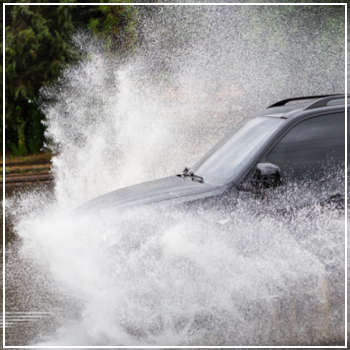Contrary to popular belief, it doesn’t take a massive amount of water to cause significant damage to your car. Even a few inches of water can wreak havoc on your engine and other critical internal components. Next time you're tempted to drive through flooded areas after a storm, keep these points in mind. Driving through puddles or flooded roads at high speeds is risky business. First off, you can't always tell how deep the water really is—what looks shallow might actually be deeper than expected. Additionally, submerged objects like debris or sharp rocks can pose a threat to your tires, potentially leading to a flat or worse, a breakdown. Beyond the obvious dangers, driving through moving water that's at least four inches deep or standing water that's six inches deep can severely damage your car's internal systems: High-speed driving through floods increases the risk of hydroplaning, which can result in loss of vehicle control. Depending on your location, this could lead to collisions with other vehicles, pedestrians, or property damage. If your car stalls while driving through floodwaters, attempting to restart it is a bad idea. This action forces even more water into the engine, potentially causing further damage and more expensive repairs. There are multiple ways water can harm your engine when driving through a flooded area. The faster you go, the greater the likelihood of splashing water onto your engine. Driving above 25 miles per hour can overwhelm your engine's capabilities. However, the engine isn't the only part you should be worried about. Water can enter through other openings, such as the vent pipe, potentially leading to transmission failure. Similarly, the air intake might suck in water, allowing it to seep into the engine's cylinders. This situation creates hydrostatic lock, where the pistons seize up and the engine stalls, impacting other essential parts in the process. Even a small amount of moisture can cause hydrostatic lock. After driving through a flood, inspect the area beneath the bumper. If you notice any moisture or dampness, there's a good chance water has entered the air intake and possibly damaged the engine. Just because your car starts the day after driving through flood conditions doesn't mean it's safe to use. Hidden problems can arise later, even if you don’t immediately notice any visible signs of moisture. A key indicator that something is wrong? Look for water in the oil, differential fluid, and transmission fluid. Pay attention to the condition of the belts and the intake manifold as well. While a quick inspection by yourself might give you some insight, it’s always best to have a professional mechanic or technician thoroughly assess your car for any potential damage. Not only should they inspect the mechanical and electrical systems, but they’ll likely need to flush and replace the fluids. If you're concerned about flood damage to your car, bring it to DaSilva’s Auto Body for a comprehensive evaluation. To schedule an appointment, contact us today. Sodium Tripolyphosphate 94% or named : PENTA-SODIUM TRIPHOSPHATE, PENTASODIUM TRIPOLYPHOSPHATE,SODIUM TRIPHOSPHATE PENTABASIC,SODIUM TRIPOLYPHOSPHATE PENTABASIC. GB/T 9983-2004 Chemical formula: na5p3o10 Molecular weight: 367.86 CAS No.: 7758-29-4 EINECS No.: 231-838-7 Sodium tripolyphosphate has the functions of chelation, suspension, dispersion, gelling, emulsification and pH buffer. It can be used as main additives of synthetic Detergent, industrial water softening agent, tanning pretanning agent, dyeing additives, organic synthesis catalyst, dispersant of pharmaceutical industry and food additives. In addition to exporting STPP, domestic STPP consumption is mainly concentrated in detergent industry, food, ceramics, etc. sodium triphosphate 94%, pentasodium phosphate,Na5P3O10,Sodium Tripolyphosphate tech grade , STPP Henan Chuange Industry CO.,LTD , https://www.chuangegroup.com After a heavy downpour, large puddles often linger on the roads. In severe situations, nearby rivers can overflow their banks, leaving several inches of water covering the streets. While you might think your car can handle a few inches of standing water, have you ever considered how this could impact your vehicle?
After a heavy downpour, large puddles often linger on the roads. In severe situations, nearby rivers can overflow their banks, leaving several inches of water covering the streets. While you might think your car can handle a few inches of standing water, have you ever considered how this could impact your vehicle?Water Hazards
Damage to Your Engine
Is Your Car Salvageable?
How Driving Through a Flood Can Damage Your Car
Sodium polyphosphate is white powder crystal with good fluidity. It is commonly known as pentasodium because its molecule (na5p3o10) has five sodium atoms. Sodium tripolyphosphate is easily soluble in water and its aqueous solution is alkaline, so most of it is used in synthetic detergents.
Next Article
Rümi Wins Alberta's Top Employer Award for 2024
Prev Article
How Driving Through a Flood Can Damage Your Car